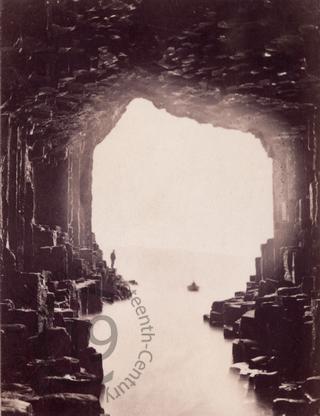
Fingal's Cave on Staffa
A carte-de-visite showing a view of Fingal’s Cave on the uninhabited island of Staffa, in the Inner Hebrides of Scotland. The photograph has been taken from inside the cave, looking out across the sea towards the island of Iona. A solitary figure standing on the edge of the entrance gives the composition a sense of scale.
It became known as Fingal's Cave after the eponymous hero of an epic poem by 18th-century Scots poet-historian James Macpherson. It is formed entirely from hexagonally jointed basalt columns within a Paleocene lava flow, similar in structure to the Giant's Causeway in Northern Ireland. Its size and naturally arched roof, and the eerie sounds produced by the echoes of waves, give it the atmosphere of a natural cathedral.
The cave became a popular tourist destination in the nineteenth century. Famous visitors included Jules Verne, William Wordsworth, John Keats, Lord Tennyson and J. M. W. Turner, who painted Staffa, Fingal's Cave in 1832. Queen Victoria also made the trip.
Photographer unidentified.
Code: 125658




